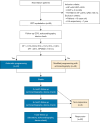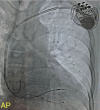Evaluating the efficacy, safety, and predictors of failure following cardiac resynchronization therapy in a developing country: an ambispective, multi-center study
- PMID: 40115087
- PMCID: PMC11921262
- DOI: 10.21037/cdt-24-408
Evaluating the efficacy, safety, and predictors of failure following cardiac resynchronization therapy in a developing country: an ambispective, multi-center study
Abstract
Background: Multiple studies have demonstrated that cardiac resynchronization therapy (CRT) effectively improves the prognosis of heart failure. CRT has been proven to improve patients' quality of life and reduce the risk of readmission and death in selected patients. Nevertheless, a notable proportion of individuals undergoing CRT showed no response. Therefore, we conducted this study to describe CRT characteristics and reported the outcomes 1 year after discharge in Vietnam, along with predictors of non-response to CRT.
Methods: This was a multicenter, ambispective cohort study that enrolled all CRT implantation patients at five hospitals in Ho Chi Minh City: University Medical Center Ho Chi Minh City, Heart Institute of Ho Chi Minh City, Tam Duc Heart Hospital, Thong Nhat Hospital, and Vinmec Central Park Hospital. All patients received treatment according to established guidelines and were monitored for up to 1 year after being discharged. Primary outcomes included rehospitalization and mortality rate 1 year after discharge. Secondary outcomes included early and late complications related to the procedure.
Results: Between April 2016 and April 2020, 88 cases of successful CRT implantation from five hospitals were enrolled. The majority of the population was male (68.2%), mean age was 62.5±13.4 years old, New York Heart Association (NYHA) III/IV at admission (98.9%), and the mean left ventricular ejection fraction (LVEF) was 24%±5.9%. The incidence of early complications was 9.1%. The overall mortality rate was 12.5%, with 6.8% occurring within the 1-year follow-up period. The population experienced a significant decrease in readmission rate within 1 year after discharge (P=0.001). Additionally, there was a notable improvement in the NYHA function (P<0.001) and an enhancement in the quality of life (P=0.001). Five characteristics correlated with the lack of response to CRT were history of dobutamine usage, QRS interval (QRS) length before implantation, severe ventricular arrhythmias before implantation, atrial fibrillation after implantation, and severe ventricular arrhythmias after implantation.
Conclusions: Properly used CRT device improves heart failure symptoms, mortality, and readmissions. There are several predictors of cardiac resynchronization treatment failure. This information helps us comprehend the restricted patient group and develop better treatments, especially in low-income countries.
Keywords: Heart failure; cardiac resynchronization therapy (CRT); mortality; predictors of failure; rehospitalization.
Copyright © 2025 AME Publishing Company. All rights reserved.
Conflict of interest statement
Conflicts of Interest: All authors have completed the ICMJE uniform disclosure form (available at https://cdt.amegroups.com/article/view/10.21037/cdt-24-408/coif). The authors have no conflicts of interest to declare.
Figures



Similar articles
-
Biventricular pacing (cardiac resynchronization therapy): an evidence-based analysis.Ont Health Technol Assess Ser. 2005;5(13):1-60. Epub 2005 Sep 1. Ont Health Technol Assess Ser. 2005. PMID: 23074464 Free PMC article.
-
Determinants of mortality in patients undergoing cardiac resynchronization therapy: baseline clinical, echocardiographic, and angioscintigraphic evaluation prior to resynchronization.Pacing Clin Electrophysiol. 2005 Dec;28(12):1260-70. doi: 10.1111/j.1540-8159.2005.00266.x. Pacing Clin Electrophysiol. 2005. PMID: 16403157
-
[A multi-center study on the long-term mortality and related risk factors in patients with chronic heart failure receiving resynchronization therapy].Zhonghua Xin Xue Guan Bing Za Zhi. 2016 Nov 24;44(11):951-955. doi: 10.3760/cma.j.issn.0253-3758.2016.11.010. Zhonghua Xin Xue Guan Bing Za Zhi. 2016. PMID: 27903393 Chinese.
-
Cardiac resynchronization therapy and implantable cardiac defibrillators in left ventricular systolic dysfunction.Evid Rep Technol Assess (Full Rep). 2007 Jun;(152):1-199. Evid Rep Technol Assess (Full Rep). 2007. PMID: 17764218 Free PMC article. Review.
-
An individual patient meta-analysis of five randomized trials assessing the effects of cardiac resynchronization therapy on morbidity and mortality in patients with symptomatic heart failure.Eur Heart J. 2013 Dec;34(46):3547-56. doi: 10.1093/eurheartj/eht290. Epub 2013 Jul 29. Eur Heart J. 2013. PMID: 23900696 Free PMC article. Review.
References
-
- Yokoshiki H, Shimizu A, Mitsuhashi T, et al. Cardiac resynchronization therapy with a defibrillator in non-ischemic and ischemic patients for primary and secondary prevention of sudden cardiac death: Analysis of the Japan cardiac device treatment registry database. J Arrhythm 2023;39:757-65. 10.1002/joa3.12916 - DOI - PMC - PubMed
LinkOut - more resources
Full Text Sources
Research Materials
Miscellaneous
